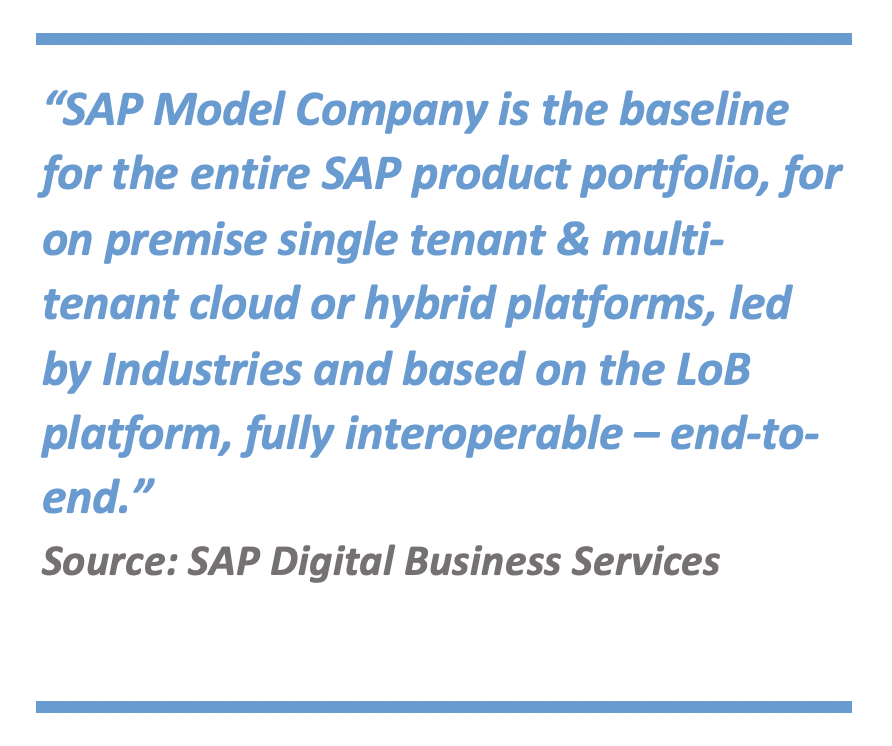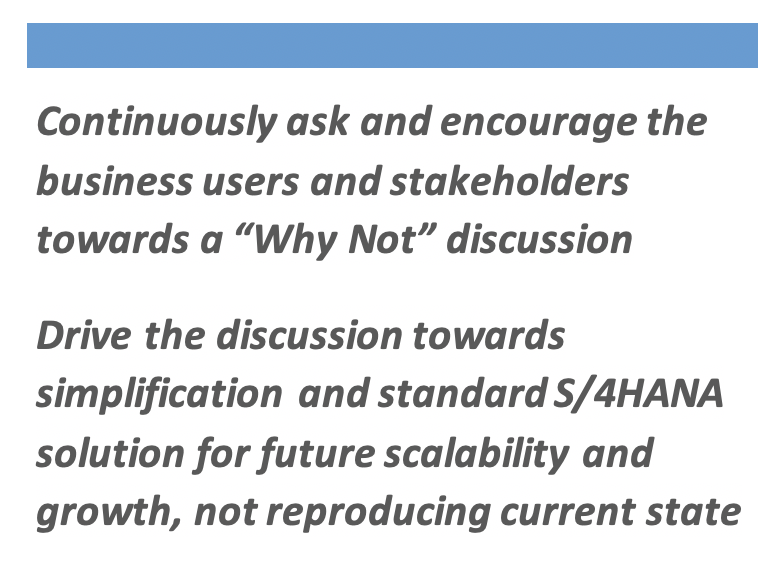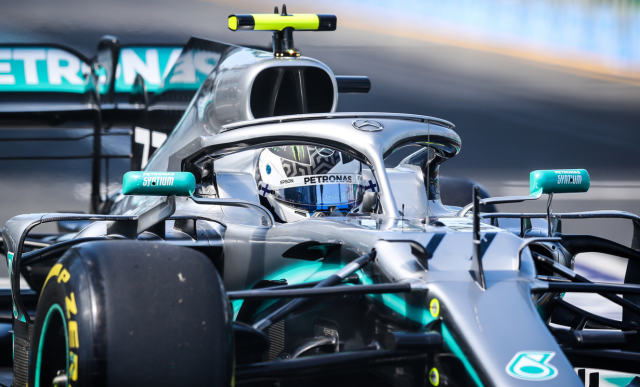How to efficiently leverage the SAP Model Company to achieve maximum business value in a SAP S/4HANA transformation
By Pallab Halder, Director, C&SI NextGen Enterprise Transformation Services, Tata Consultancy Services
Digital transformation in this era of Industry 4.0 is reinventing the global economy where not only businesses, but also individuals and societies, are becoming more collaborative, responsive, and efficient. Technology platforms that are intelligent, agile, and automated are driving this transformation and delivering fundamentally different business outcomes.
The need for a rapid and agile transformation with optimized long term TCO while also managing continuous innovation is forcing business leaders to rethink how best to implement business and IT applications. The debate is between ‘Fit-to-Standard’ (standardized out-of-box solution with embedded leading practices in out-of-box application software) vs. ‘Fit-to-Requirement’ (highly customized solution for the requirements of the business and organization).
This document explores the approach and methods to address this question in the context of SAP business transformation, leveraging SAP Model Company pre-configured reference solution for a ‘Fit-to-Standard’ SAP implementation, to achieve rapid, agile business outcomes, while also addressing the need for ‘Fit-to-Requirement’ process innovation and differentiation in the market.
SAP Model Company: An Overview
Let’s start with a quick overview of and some context around “SAP Model Company”.
What is SAP Model Company?

SAP Model Company is a pre-configured, ready-to-use, end-to-end reference solution, tailored to an industry or line of business, enabling organizations to simplify and accelerate SAP S/4HANA, C/4HANA, or SAP SuccessFactors digital transformation projects. It is a working SAP system with end-to-end business processes, and sample organization structure, master data, business roles, and Fiori apps. The SAP Model Company package also includes ready to use deliverables and accelerators, such as business process flows, configuration documents, and test scripts.
Types of SAP Model Company Packages
SAP Model Company is available as ‘Industry’ packages for various sectors (e.g. Consumer Goods, Retail, Life Sciences, Automotive, etc.) and as ‘Line of Business’ packages for cross-industry business functionality (e.g. Supply Chain Planning, Connected Manufacturing, Logistics Execution, etc.). SAP is continually adding new industries and lines of business in the Model Company portfolio and maintains up-to-date setup configuration and artifacts aligned to the latest S/4HANA release.
In addition, SAP offers an assemble-to-order custom fit Model Company tailored to the customer’s scope of implementation, combining the specific Industry package with various Line of Business packages and localization add-ons.
Model Company Architecture Overview
SAP Model Company reference solution package is comprised of a foundation layer built with SAP Best Practices solution package, on top of which SAP Model Company Industry and Line of Business packages are added as required and selected by the customer.
The SAP S/4HANA Best Practices solution has a default US/Germany version and a Multinational Corporations version (with 29 country versions to choose from).

Figure 1: Sample SAP Model Company Architecture; Source: SAP
SAP Model Company for S/4HANA is available on:
- Customer owned/managed Infrastructure: On-Premise and Cloud hosting platforms (Azure, AWS, Google Cloud)
- SAP hosted/managed infrastructure: SAP HANA Enterprise Cloud (HEC) and SAP Cloud
In summary, SAP Model Company provides a ready to use reference solution for a ‘Fit-to-Standard’ solution approach. It offers an accelerated path to achieve business transformation success, including faster time to value, higher user adoption, reduced change management, and lower TCO.
Leveraging SAP Model Company to achieve maximum business value
The key to maximize business value with the SAP Model Company based approach depends on several elements and their proper execution, based on our experiences across many global S/4HANA transformation programs.
1. Process Segmentation and Design Principles Alignment with Model Company
A key success factor in using Model Company efficiently is to pave the foundational groundwork for solution design. This requires analyzing the organization’s in-scope business processes and completing a process segmentation exercise. The key is not to treat all business processes in the organization as equal, but to segment the processes by complexity and differentiation to determine the right design principles and approach to each process, and then to apply the Model Company preconfigured reference solution accordingly.
Process Segmentation:
The entire set of in-scope business processes can be segmented broadly into ‘Core’ and ‘Differentiating’ processes.
Core processes: These are must-have basic operational and industry standard processes (e.g. transactional procurement, order management, production, financial, etc.) where an organization needs to drive standardization and automation to be at least at par with the industry and to focus on productivity and efficiency. Typically, these will be around 80-90% of the total in-scope processes.
Differentiating processes: These are industry leading processes which differentiate an organization from the competition and drives market advantage. The differentiating processes vary by type of industry and by customer demand for goods and services (e.g. customer relationship, pricing [Amazon and Netflix], product innovation, engineering [Apple, Google, Facebook], manufacturing excellence [GE, Toyota], and logistics efficiency [FedEx, Walmart]). Typically, these make up no more than 10-20% of the total in-scope processes.
Alignment of Design Principles:
The objective and philosophy behind this segmentation is to apply the right design principles for solution design in SAP S/4HANA.
For Core Processes (80-90%) – Utilize a ‘Solution Validation-Why Not’ approach to review and validate the delivered out-of-the-box preconfigured business scenarios in SAP Model Company. This is the ‘Fit-to-Standard’ design principle which will primarily follow standard vanilla S/4HANA functionality without additional customization or long-term IT investment. However, depending on specific organization dynamics (e.g. GL naming conventions, product harmonization across lines of business, etc.) there will be additional configuration and/or modifications to existing S/4HANA system settings (above and beyond what is delivered by the Model Company pre-configured reference solution). This also drives process standardization across different lines of business and adoption of industry leading practices.
For Differentiating Processes (10-20%) – Follow a ‘Fit-to-Requirement’ approach through assessment, industry insights, and design thinking to create differentiated capabilities. However, even for these processes, there needs to be a value-based dialogue with the business to adopt best practices in SAP Model Company wherever possible.
In summary, use the ‘Fit-to-Standard’ Why Not design principle for Core processes to standardize, automate, and minimize TCO and use the ‘Fit-to-Requirement’ principle for Differentiating processes to innovate and drive business impact.
2. Solution Design Structuring and Approach Alignment with Model Company
Once the process segmentation is complete, the next step to successfully leverage SAP Model Company is to structure and plan the design workshops based on the design principles. The project team must define a structured and rigorous approach of outcome driven ‘Fit-to-Standard’ solution validation workshops and necessary ‘Fit-to-Requirement’ design thinking workshops for an integrated end-to-end solution design. An Agile delivery methodology based on SAP Activate (e.g. Transformation Delivery Methodology [TDM] by TCS) should be embedded in the overall design and delivery mechanism.

Figure 2: Sample decision tree to align Model Company preconfigured processes with Design Principles
The above decision tree approach uses process segmentation to plan and structure the design workshops in a progressive manner and leverages the full potential of Model Company preconfigured processes and accelerators.
Prior to launching into the actual design workshops, the project team must carefully plan and prepare the below activities.
Key Design Decisions:
These are the set of critical strategic decisions that have much long lasting impact on the solution and cannot be changed easily after go-live (e.g. global product numbering standard, global and regional S&OP roles and organization, global chart of accounts structure, etc.) The core project implementation team must work closely with business leads and Subject Matter Experts (SMEs) to define these high-level design decisions that address the current business needs and is also flexible and scalable for the future.
SAP Model Company will impact these key design decisions in both ways. The Model Company best practice processes and architectural elements should be considered during the decision-making process. Also, the output key design decisions will influence how the preconfigured processes, data structures, and configuration will need to be used or adapted for the final design.
Preconfigured Scenarios and Data Preparation:
SAP S/4HANA Model Company package must be installed and tested thoroughly by the project team, including testing the delivered Fiori apps and the embedded analytics and reports.
In addition, it is advisable to seed some sample data sets in the system (e.g. material, customer, vendor data), testing the preconfigured scenarios with the data, and using them in ‘Show and Tell’ solution validation workshops to better engage the business users and SMEs in the design decisions. We recommend minimal changes to the supplied data set of Model Company-mainly description changes instead of actual data set changes so that the preconfigured scenarios don’t get impacted.
3. Structured Solution Validation Execution driven by Model Company

The key to delivery success is to conduct and complete the solution design and delivery following the core mantra of “Fit-to-Standard” to deliver business outcomes:
- “Show and Tell” – Start with Model Company delivered process flows and the preconfigured system steps for the process or scenario being designed.
- Identify Gaps in the Model Company best practice processes for necessary adjustments and/or customizations. Focus and prioritize gaps that drive one of the following business values – legal/statutory requirement, competitive differentiation, operational efficiency, and cost reduction.
- Highlight any cross-functional integration that is relevant for this process and determine relevant Model Company scenarios for follow-up sessions.
- Identify design thinking workshops for ‘Fit-to-Requirement’ processes that drive tangible business differentiation and value.
- Start with simple processes by business functions and teams to lay the foundation and build progressively more complex and cross-functional processes, including ‘Fit-to-Requirement’ processes that drive tangible business differentiation and value. This will also help manage business adoption and change impact.
- Leverage and re-use SAP Model Company supplied solution accelerators as much as possible – Business Process Flows, Process Scripts, Configuration Documents, Business Roles Library, etc., to produce necessary documentation while keeping the focus on rapid and agile design outcome.
Decision Framework for choosing Model Company
The CXO suite and transformation leadership needs to analyze a decision framework that fits the business to decide between adopting a ‘Fit-to-Standard’ approach using a reference solution like SAP Model Company or a ‘Fit-to-Requirement’ approach. Below is a notional table for a qualitative analysis of the decision options.

* Qualitative rating. ++ (very positive) … o (neutral) … – – (very negative)
Figure 3: Qualitative Decision Framework for Model Company adoption in transformation program
Finally, the success of the transformation journey depends on the ability to strike the right balance between business outcome and minimizing TCO and change management.
Conclusion
In this era of Industry 4.0, the need for a rapid and agile digital transformation with optimized long term TCO while managing continuous innovation is driving a paradigm shift in how business applications like SAP S/4HANA are implemented and maintained – from a high customizable ‘Fit-to-Requirement’ to a simplified and agile ‘Fit-to-Standard’ approach. SAP S/4HANA Model Company reference solution platform enables this new way of delivering SAP enabled business transformation, provided the fundamentally different approach, practices and mindset are embraced across the project team and business leaders, who generally may have experience with the traditional approach of customized IT systems and applications.








